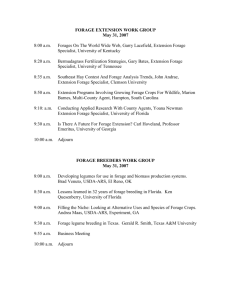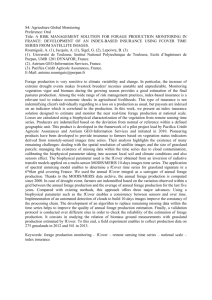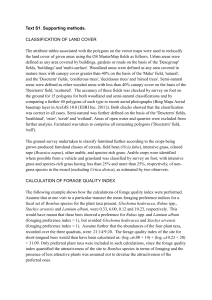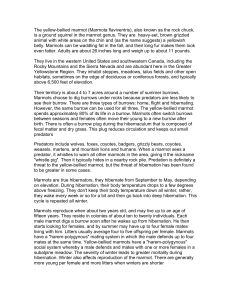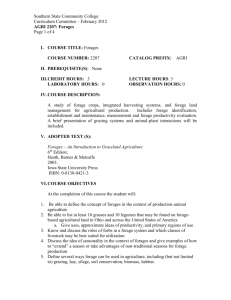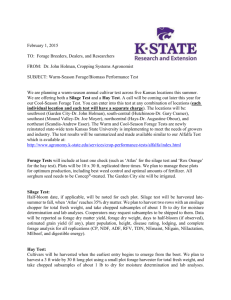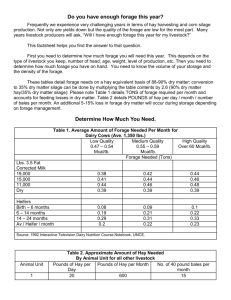March 2014
advertisement
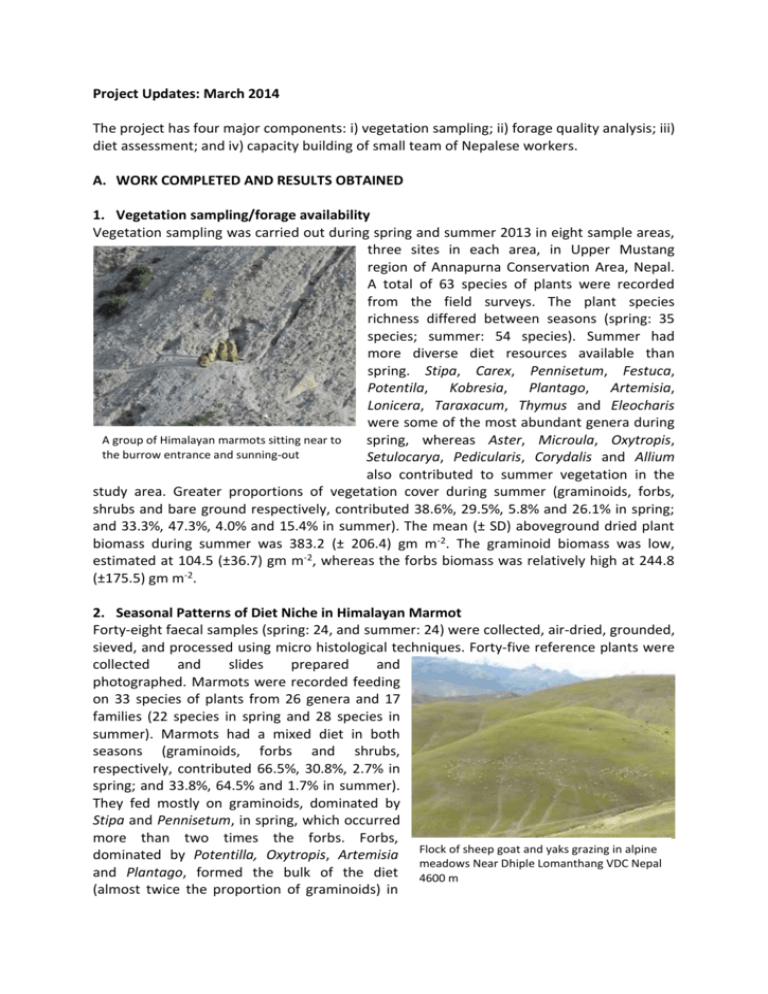
Project Updates: March 2014 The project has four major components: i) vegetation sampling; ii) forage quality analysis; iii) diet assessment; and iv) capacity building of small team of Nepalese workers. A. WORK COMPLETED AND RESULTS OBTAINED 1. Vegetation sampling/forage availability Vegetation sampling was carried out during spring and summer 2013 in eight sample areas, three sites in each area, in Upper Mustang region of Annapurna Conservation Area, Nepal. A total of 63 species of plants were recorded from the field surveys. The plant species richness differed between seasons (spring: 35 species; summer: 54 species). Summer had more diverse diet resources available than spring. Stipa, Carex, Pennisetum, Festuca, Potentila, Kobresia, Plantago, Artemisia, Lonicera, Taraxacum, Thymus and Eleocharis were some of the most abundant genera during A group of Himalayan marmots sitting near to spring, whereas Aster, Microula, Oxytropis, the burrow entrance and sunning-out Setulocarya, Pedicularis, Corydalis and Allium also contributed to summer vegetation in the study area. Greater proportions of vegetation cover during summer (graminoids, forbs, shrubs and bare ground respectively, contributed 38.6%, 29.5%, 5.8% and 26.1% in spring; and 33.3%, 47.3%, 4.0% and 15.4% in summer). The mean (± SD) aboveground dried plant biomass during summer was 383.2 (± 206.4) gm m-2. The graminoid biomass was low, estimated at 104.5 (±36.7) gm m-2, whereas the forbs biomass was relatively high at 244.8 (±175.5) gm m-2. 2. Seasonal Patterns of Diet Niche in Himalayan Marmot Forty-eight faecal samples (spring: 24, and summer: 24) were collected, air-dried, grounded, sieved, and processed using micro histological techniques. Forty-five reference plants were collected and slides prepared and photographed. Marmots were recorded feeding on 33 species of plants from 26 genera and 17 families (22 species in spring and 28 species in summer). Marmots had a mixed diet in both seasons (graminoids, forbs and shrubs, respectively, contributed 66.5%, 30.8%, 2.7% in spring; and 33.8%, 64.5% and 1.7% in summer). They fed mostly on graminoids, dominated by Stipa and Pennisetum, in spring, which occurred more than two times the forbs. Forbs, dominated by Potentilla, Oxytropis, Artemisia Flock of sheep goat and yaks grazing in alpine meadows Near Dhiple Lomanthang VDC Nepal and Plantago, formed the bulk of the diet 4600 m (almost twice the proportion of graminoids) in summer. In both seasons, marmots had less shrubs, dominated by Lonicera in their diets. Marmots’ diet niche breadth was wide during summer (Standardized Shanon-Weiner index = 0.77) than during spring (= 0.60). Marmots had quite similar diets in both seasons (the modified Morisita’s index of diet similarity between two seasons was 0.77 at the species level and 0.79 at the forage class level). Overall, marmots used the forage classes according to availability during both seasons. Compositional analysis ranked forage classes in the order: graminoids > forbs > shrubs (spring) and forbs > graminoids > shrubs (summer). 3. Nutritional Quality of Marmot Diets Twenty-two potential forage species collected during summer 2013 and processed using the standard laboratory procedures. Dry matter (DM), crude protein (CP), total ash, organic matter (OM), acid detergent fibre (ADF), neutral detergent fibre (NDF), acid detergent lignin (ADL) and energy content estimated. Data were analysed for 12 most selected forage species, and compare the forage quality with selection. Plant species varied in terms of their water content, crude protein, mineral matter, organic matter, fibreousness and energy contents. The crude protein value ranged between 9.72 and 17.86%, indicating all species are of moderate quality forage in terms of CP. All species had <31% ADF and <40% NDF except K. mallae and L. spinosa implying all species are good forage species. The highest percentage of acid detergent lignin was recorded in Lonicera spinosa, but lowest was from Aster indamellus. Lonicera spinosa had the highest energy content and Plantago erosa had the lowest. No significant correlations were obtained between diet selection and forage quality in terms of water content, organic matter, total ash, crude protein, NDF, ADF, ADL and energy content. There was no significant effect of forage quality on forage selection. There were weak positive relationships between selection and crude protein, ash and ADF, and weak negative relationships with water content, energy, NDF and ADL. 4. Capacity Building Local herders and community members were consulted to select study sites. Seven local people trained and engaged in the field work during 2013. They developed some skills and knowledge about marmot, their food and feeding habits. Few people directly involved in lab works (plant identification, nutritional analyses, diet analyses). Most importantly, three halfday conservation workshops were organised in Kimling, Dhiple and Lomanthang area and different aspects of marmot and livestock food and feeding strategies were discussed. B. WORK SCHEDULED Few grasses were difficult to identify to species level, so they were lumped by genus in the analysis. Unidentified plant species during field survey 2013 will be collected this year (June-July, 2014), herbarium specimens will be prepared and identified with help of experts at National Herbarium. Nutritional quality of most selected species were analysed with respect to selection in 2013. During 2014 field work, the twigs and new leaves of three most rejected and three indifferent species that are neither selected nor rejected, but used in a similar proportion as available will be collected from 6 of the 24 sites, and compared with their respective selection values. Local people will be involved in field work and technical officers/experts will test nutritional status of marmot diets. The draft report will be finalised after this year’s field visit.


